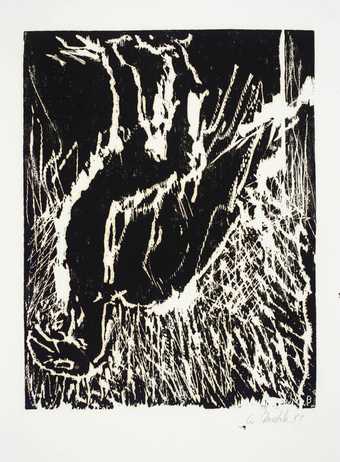
Georg Baselitz
Eagle
(1981)
Tate
A print is an impression made by any method involving transfer from one surface to another

Georg Baselitz
Eagle
(1981)
Tate
Aquatint is a printmaking technique that produces tonal effects by using acid to eat into the printing plate creating sunken areas which hold the ink
Drypoint is a printmaking process in which a design is drawn on a plate with a sharp, pointed needle-like instrument
Engraving is a printmaking technique that involves making incisions into a metal plate which retain the ink and form the printed image
Etching is a printmaking technique that uses chemical action to produce incised lines in a metal printing plate which then hold the applied ink and form the image
Intaglio describes any printmaking technique in which the image is produced by incising into the printing plate – the incised line or area holds the ink and creates the image
Lithography is a printing process that uses a flat stone or metal plate on which the image areas are worked using a greasy substance so that the ink will adhere to them by, while the non-image areas are made ink-repellent
The monoprint is a form of printmaking where the image can only be made once, unlike most printmaking which allows for multiple originals
Offset lithography is a variation of the printing technique lithography
A variety of stencil printing, using a screen made from fabric (silk or synthetic) stretched tightly over a frame
Proof is a printing term applied to all individual impressions made before work on a printing plate or block is completed, in order to check progress of the image
A method of relief printing from a block of wood cut along the grain
A printmaking method distinct from woodcut in that the line is incised into the woodblock, rather than the background being cut away to leave a line in relief
William Hogarth was one of the founders of a satire that led all the way to the modern comic book and was described as the grandfather of the political cartoon. Martin Rowson revisits Hogarth’s most political details such as Gin Lane.
The prints in this exhibition were all made between 1933 and 1963 in Paris, Barcelona and Mallorca, where Miró lived at various times.